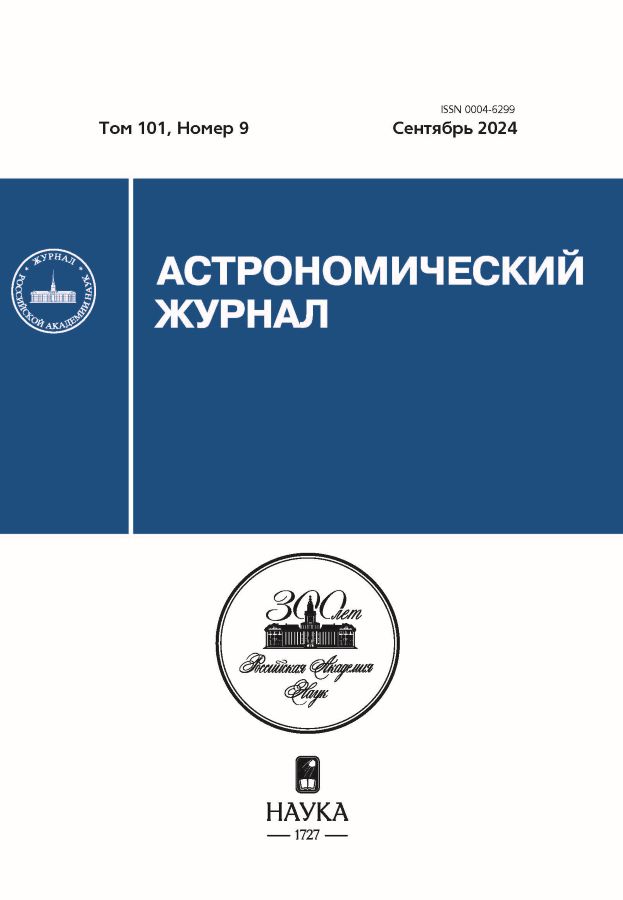The [N/C] value as an indicator of the red giant evolution: observed differences between magnetic and non-magnetic giants
- Authors: Lyubimkov L.S.1, Poklad D.B.1
-
Affiliations:
- Crimean Astrophysical Observatory of the Russian Academy of Sciences
- Issue: Vol 101, No 9 (2024)
- Pages: 851-859
- Section: Articles
- URL: https://cardiosomatics.ru/0004-6299/article/view/647664
- DOI: https://doi.org/10.31857/S0004629924090057
- EDN: https://elibrary.ru/IBDNRI
- ID: 647664
Cite item
Abstract
An analysis is performed of data concerning the [N/C] value, one of the most sensitive indicators of stellar evolution, for 20 red giants with magnetic fields in comparison with similar data for 7 non-magnetic giants. For the most giants in question the [N/C] value showed a dependence on the age t and mass M. In particular, the [N/C] value for the most of magnetic giants decreases from 1.2 to 0.9 when logt increases from 8.2 to 9.8 and M increases from 1 to 4 M⊙. It was shown that for the most of magnetic giants the [N/C] values are lowered (up to 0.4 dex) as compared with non-magnetic giants with the same values of t or M. The supposition was made that such differences in the [N/C] values between these two groups of stars are explained by different ways of stellar evolution of red giants with magnetic fields (on the main sequence (MS) stage the fields could be strong) and giants without magnetic fields. In particular, the magnetic field can suppress the mixing process on the MS stage already and especially in the First Dredge-Up (FDU) phase; that leads to the [N/C] lowering in magnetic giants.
Keywords
Full Text
About the authors
L. S. Lyubimkov
Crimean Astrophysical Observatory of the Russian Academy of Sciences
Author for correspondence.
Email: lyub@craocrimea.ru
Russian Federation, Nauchny
D. B. Poklad
Crimean Astrophysical Observatory of the Russian Academy of Sciences
Email: dmitry.crao@gmail.com
Russian Federation, Nauchny
References
- L. S. Lyubimkov, S. A. Korotin, D. V. Petrov, D. B. Poklad, D. E. Mkrtichian, I. Han, and B.-C. Lee, Astron. Nachricht. 342, 497 (2021).
- Л. С. Любимков, С. А. Коротин, Д. В. Петров, Д. Б. Поклад, Д. О. Кудрявцев, Д. Н. Бакланова, Астрофизика 65, 63 (2022).
- Л. С. Любимков, Д. Б. Поклад, С. А. Коротин, Астрофизика 65, 515 (2022).
- L. S. Lyubimkov, S. A. Korotin, D. V. Petrov, and D. B. Poklad, Monthly Not. Roy. Astron. Soc. 528, 304 (2024).
- K. Lodders, Space Sci. Rev. 217, id. 44 (2021).
- G. Casali, L. Magrini, E. Tognelli, R. Jackson, et al., Astron. and Astrophys. 629, id. A62 (2019).
- M. Aurière, R. Konstantinova-Antova, C. Charbonnel, G. A. Wade, et al., Astron. and Astrophys. 574, id. A90 (2015).
- J. Choi, A. Dotter, C. Conroy, M. Cantiello, B. Paxton, and B. D. Johnson, 823(2), id. 102 (2016).
- C. Georgy, S. Ekström, A. Granada, G. Meynet, N. Mowlavi, P. Eggenberger, and A. Maeder, Astron. anf Astrophys. 553, id. A24 (2013).
- C. Abia, S. Palmerini, M. Busso, and S. Cristallo, Astron. and Astrophys. 548, id. A55 (2012).
- M. Shetrone, J. Tayar, J. A. Johnson, G. Somers, et al., 872(2), id. 137 (2019).
- P. L. North, J. Babel, and D. Erspamer, Contrib. Astron. Observ. Skalnate Pleso 38, 375 (2008).
- J. D. Landstreet, in Magnetic Stars, Proc. Intern. Conf., held in the Special Astrophysical Observatory of the Russian AS, August 27–31, 2003, edited by Yu. Glagolevskij, D. Kudryavtsev, and I. Romanyuk, p. 11 (2004).
- L. S. Lyubimkov, D. L. Lambert, S. A. Korotin, T. M. Rachkovskaya, and D. B. Poklad, Monthly Not. Roy. Astron. Soc. 446, 3447 (2015).
Supplementary files














